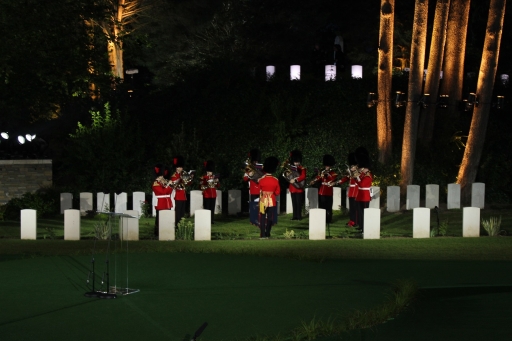Royalty, heads of state, and families of those who had died in the war gathered at the St Symphorien Military Cemetery near Mons in Belgium this evening for what the Commonwealth War Graves Commission described as “a unique act of commemoration” to mark the Centenary of the outbreak of the First World War.
Among those attending the event were the Duke and Duchess of Cambridge, Prince Harry, the King and Queen of the Belgians, Prime Ministers David Cameron of the UK and Elio Di Rupo of Belgium, and Presidents Joachim Gauck of the Federal Republic of Germany and Michael Higgins of Ireland.
The CWGC’s Director General, Mr Brian Davidson, said: “St Symphorien is a uniquely fitting place for us to gather in a spirit of common remembrance. On land donated by a Belgian, in a cemetery first built by the German Army and now cared for by the CWGC, the fallen from both sides of the conflict lie together at peace. Today we remember them all”.
The Duke and Duchess of Cambridge, Prince Harry, and David Cameron arriving at the event
The event, broadcast live, was presented by British historian Dan Snow, and had both serving soldiers and relatives of those who had died in the conflict reading excerpts from First World War diaries and letters.
They included the grand niece of John Parr, the first British soldier to be killed in the war, and who is buried at St Symphorien. She read out the poignant letter that John Parr’s mother had written to the War Office asking for information about her 17 year old son: “I have not heard form him at all and the War Office can tell me nothing … An early reply will oblige.”
And Britain’s Prince Harry read a section of a letter sent by Private Michael Lennon, of the Royal Dublin Fusiliers, a few weeks before he was killed at Gallipoli.
Private Lennon had written: “We can only hope that we have all the luck to come through the night and if I should get bowled out – well it can’t be helped.’
The British Prime Minister David Cameron said: ” Every war is cruel but this war was unlike any other – the unspeakable carnage, the unberable loss, the almost unbelievable bravery.
“One hundred years on, it is right that we meet here and around the world to remember.”
The London Symphony Orchestra and Berlin Philharmonic came together to play Brahms’ Requium.
As dusk fell, wreaths and lanterns were laid at an obelisk in the centre of the cemetery – and The Last Post was sounded.

The large screen at St Symphorien – part of the TV broadcast staging
Background to the Event
The CWGC issued the following background information:
Within weeks of Britain declaring war on Germany on 4 August 1914, forces from the two nations first clashed outside the Belgian city of Mons. The British suffered some 1,600 casualties, the Germans 2,000.
After the battle, the dead of both sides were buried in numerous sites throughout the twelve boroughs of Mons, but in the spring of 1916, a German officer approached a local landowner with a proposition. The German Army was in search of a plot of land on which to build a cemetery to bring together the graves of friend and foe alike. From the outset, there was an understanding that the graves of both nations would be treated with equal respect.
Today, St Symphorien is the final resting place of 229 Commonwealth and 284 German servicemen. It contains the graves of the first and last British and Commonwealth soldiers to be killed on the Western Front. Private John Parr is believed to be the first British soldier to be killed, Privates George Ellison and Canadian George Price are the last – both were killed on 11 November 1918.
Posted by: CN Editor, reporting from St Symphorien
Photos copyright Centenary News
